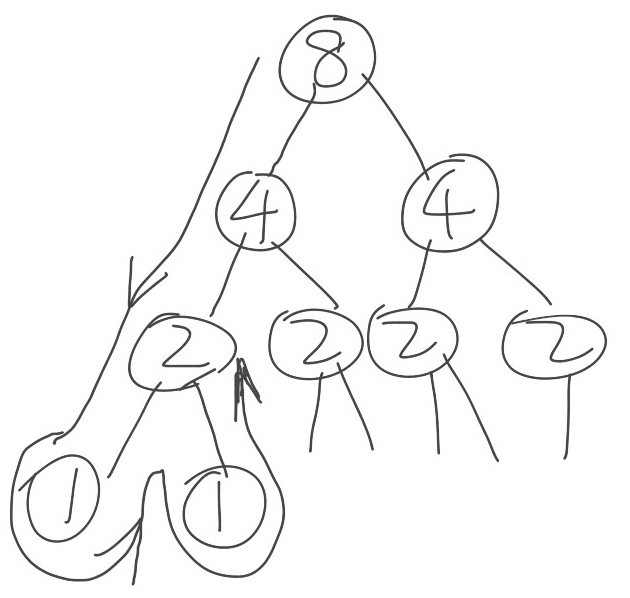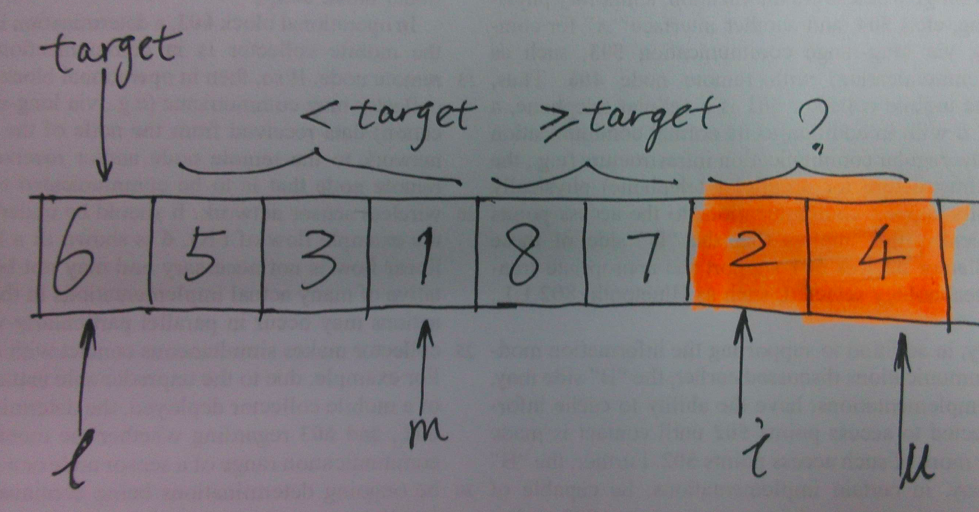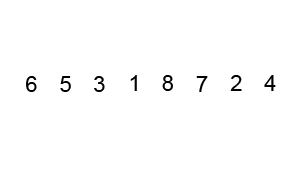- algorithm-reading
- leetcode/lintcode题解/算法学习笔记
- 1. Part I - Basics
- 2. Data Structure
- 3. Basics Sorting
- 4. Basics Misc
- 5. Part II - Coding
- 6. String - 字符串
-
7.
Integer Array - 整型数组
- 7.1. Remove Element
- 7.2. Zero Sum Subarray
- 7.3. Subarray Sum K
- 7.4. Subarray Sum Closest
- 7.5. Product of Array Exclude Itself
- 7.6. Partition Array
- 7.7. First Missing Positive
- 7.8. 2 Sum
- 7.9. 3 Sum
- 7.10. 3 Sum Closest
- 7.11. Remove Duplicates from Sorted Array
- 7.12. Remove Duplicates from Sorted Array II
- 7.13. Merge Sorted Array
- 7.14. Merge Sorted Array II
- 7.15. Median
-
8.
Binary Search - 二分搜索
- 8.1. Binary Search
- 8.2. Search Insert Position
- 8.3. Search for a Range
- 8.4. First Bad Version
- 8.5. Search a 2D Matrix
- 8.6. Find Peak Element
- 8.7. Search in Rotated Sorted Array
- 8.8. Find Minimum in Rotated Sorted Array
- 8.9. Search a 2D Matrix II
- 8.10. Median of two Sorted Arrays
- 8.11. Sqrt x
- 8.12. Wood Cut
- 9. Math and Bit Manipulation - 数学技巧与位运算
-
10.
Linked List - 链表
- 10.1. Remove Duplicates from Sorted List
- 10.2. Remove Duplicates from Sorted List II
- 10.3. Remove Duplicates from Unsorted List
- 10.4. Partition List
- 10.5. Two Lists Sum
- 10.6. Two Lists Sum Advanced
- 10.7. Remove Nth Node From End of List
- 10.8. Linked List Cycle
- 10.9. Linked List Cycle II
- 10.10. Reverse Linked List
- 10.11. Reverse Linked List II
- 10.12. Merge Two Sorted Lists
- 10.13. Merge k Sorted Lists
- 10.14. Reorder List
- 10.15. Copy List with Random Pointer
- 10.16. Sort List
- 10.17. Insertion Sort List
- 10.18. Check if a singly linked list is palindrome
- 11. Reverse - 翻转法
- 12. Binary Tree - 二叉树
- 13. Binary Search Tree - 二叉搜索树
- 14. Exhaustive Search - 穷竭搜索
- 15. Dynamic Programming - 动态规划
- 16. Appendix I Interview and Resume
Quick Sort - 快速排序
核心:快排是一种采用分治思想的排序算法,大致分为三个步骤。
- 定基准——首先随机选择一个元素最为基准
- 划分区——所有比基准小的元素置于基准左侧,比基准大的元素置于右侧
- 递归调用——递归地调用此切分过程
out-in-place - 非原地快排
容易实现和理解的一个方法是采用递归,使用 Python 的 list comprehension 实现如下所示:
#!/usr/bin/env python
def qsort1(alist):
print(alist)
if len(alist) <= 1:
return alist
else:
pivot = alist[0]
return qsort1([x for x in alist[1:] if x < pivot]) + \
[pivot] + \
qsort1([x for x in alist[1:] if x >= pivot])
unsortedArray = [6, 5, 3, 1, 8, 7, 2, 4]
print(qsort1(unsortedArray))
输出如下所示:
[6, 5, 3, 1, 8, 7, 2, 4]
[5, 3, 1, 2, 4]
[3, 1, 2, 4]
[1, 2]
[]
[2]
[4]
[]
[8, 7]
[7]
[]
[1, 2, 3, 4, 5, 6, 7, 8]
『递归 + 非原地排序』的实现虽然简单易懂,但是如此一来『快速排序』便不再是最快的通用排序算法了,因为递归调用过程中非原地排序需要生成新数组,空间复杂度颇高。list comprehension 大法虽然好写,但是用在『快速排序』算法上就不是那么可取了。
复杂度分析
在最好情况下,快速排序的基准元素正好是整个数组的中位数,可以近似为二分,那么最好情况下递归的层数为 , 咋看一下每一层的元素个数都是 , 那么空间复杂度为 无疑了,不过这只答对了一半,从结论上来看是对的,但分析方法是错的。
首先来看看什么叫空间复杂度——简单来讲可以认为是程序在运行过程中所占用的存储空间大小。那么对于递归的 out-in-place 调用而言,排除函数调用等栈空间,最好情况下,每往下递归调用一层,所需要的存储空间是上一层中的一半。完成最底层的调用后即向上返回执行出栈操作,故并不需要保存每层所有元素的值。所以需要的总的存储空间就是
不是特别理解的可以结合下图的非严格分析和上面 Python 的代码,递归调用的第一层保存8个元素的值,那么第二层调用时实际需要保存的其实仅为4个元素,逐层往下递归,而不是自左向右保存每一层的所有元素。
那么在最坏情况下 out-in-place 需要耗费多少额外空间呢?最坏情况下第 层需要 次交换,故总的空间复杂度:

in-place - 原地快排
one index for partition
先来看一种简单的 in-place 实现,仍然以[6, 5, 3, 1, 8, 7, 2, 4]为例,结合下图进行分析。以下标 和 表示数组待排序部分的下界(lower bound)和上界(upper bound),下标 表示遍历到数组第 个元素时当前 partition 的索引,基准元素为 , 即图中的 target.

在遍历到第 个元素时, 有两种可能,第一种是 , 自增往后遍历;第二种是 , 此时需要将 置于前半部分,比较简单的实现为 swap(x[++m], x[i]). 直至 i == u 时划分阶段结束,分两截递归进行快排。既然说到递归,就不得不提递归的终止条件,容易想到递归的终止步为 l >= u, 即索引相等或者交叉时退出。使用 Python 的实现如下所示:
Python
#!/usr/bin/env python
def qsort2(alist, l, u):
print(alist)
if l >= u:
return
m = l
for i in xrange(l + 1, u + 1):
if alist[i] < alist[l]:
m += 1
alist[m], alist[i] = alist[i], alist[m]
# swap between m and l after partition, important!
alist[m], alist[l] = alist[l], alist[m]
qsort2(alist, l, m - 1)
qsort2(alist, m + 1, u)
unsortedArray = [6, 5, 3, 1, 8, 7, 2, 4]
print(qsort2(unsortedArray, 0, len(unsortedArray) - 1))
Java
public class Sort {
public static void main(String[] args) {
int unsortedArray[] = new int[]{6, 5, 3, 1, 8, 7, 2, 4};
quickSort(unsortedArray);
System.out.println("After sort: ");
for (int item : unsortedArray) {
System.out.print(item + " ");
}
}
public static void quickSort1(int[] array, int l, int u) {
for (int item : array) {
System.out.print(item + " ");
}
System.out.println();
if (l >= u) return;
int m = l;
for (int i = l + 1; i <= u; i++) {
if (array[i] < array[l]) {
m += 1;
int temp = array[m];
array[m] = array[i];
array[i] = temp;
}
}
// swap between array[m] and array[l]
// put pivot in the mid
int temp = array[m];
array[m] = array[l];
array[l] = temp;
quickSort1(array, l, m - 1);
quickSort1(array, m + 1, u);
}
public static void quickSort(int[] array) {
quickSort1(array, 0, array.length - 1);
}
}
容易出错的地方在于当前 partition 结束时未将 和 交换。比较alist[i]和alist[l]时只能使用<而不是<=! 因为只有取<才能进入收敛条件,<=则可能会出现死循环,因为在=时第一个元素可能保持不变进而产生死循环。
相应的结果输出为:
[6, 5, 3, 1, 8, 7, 2, 4]
[4, 5, 3, 1, 2, 6, 8, 7]
[2, 3, 1, 4, 5, 6, 8, 7]
[1, 2, 3, 4, 5, 6, 8, 7]
[1, 2, 3, 4, 5, 6, 8, 7]
[1, 2, 3, 4, 5, 6, 8, 7]
[1, 2, 3, 4, 5, 6, 8, 7]
[1, 2, 3, 4, 5, 6, 7, 8]
[1, 2, 3, 4, 5, 6, 7, 8]
Two-way partitioning
对于仅使用一个索引进行 partition 操作的快排对于随机分布数列的效果还是不错的,但若数组本身就已经有序或者相等的情况下,每次划分仅能确定一个元素的最终位置,故最坏情况下的时间复杂度变为 . 那么有什么办法尽可能避免这种最坏情况吗?聪明的人类总是能找到更好地解决办法——使用两个索引分别向右向左进行 partition.
先来一张动图看看使用两个索引进行 partition 的过程。

- 选中
3作为基准 lo指针指向元素6,hi指针指向4, 移动lo直至其指向的元素大于等于3, 移动hi直至其指向的元素小于3。找到后交换lo和hi指向的元素——交换元素6和2。lo递增,hi递减,重复步骤2,此时lo指向元素为5,hi指向元素为1. 交换元素。lo递增,hi递减,发现其指向元素相同,此轮划分结束。递归排序元素3左右两边的元素。
对上述过程进行适当的抽象:
- 下标 和 初始化为待排序数组的两端。
- 基准元素设置为数组的第一个元素。
- 执行 partition 操作,大循环内包含两个内循环:
- 左侧内循环自增 , 直到遇到不小于基准元素的值为止。
- 右侧内循环自减 , 直到遇到不大于基准元素的值为止。
- 大循环测试两个下标是否相等或交叉,交换其值。
这样一来对于数组元素均相等的情形下,每次 partition 恰好在中间元素,故共递归调用 次,每层递归调用进行 partition 操作的比较次数总和近似为 . 故总计需 次比较。programming_pearls
Python
#!/usr/bin/env python
def qsort3(alist, l, u):
print(alist)
if l >= u:
return
t = alist[l]
i = l + 1
j = u
while True:
while i <= u and alist[i] < t:
i += 1
while alist[j] > t:
j -= 1
if i > j:
break
# swap after make sure i > j
alist[i], alist[j] = alist[j], alist[i]
# do not forget swap l and j
alist[l], alist[j] = alist[j], alist[l]
qsort3(alist, l, j - 1)
qsort3(alist, j + 1, u)
unsortedArray = [6, 5, 3, 1, 8, 7, 2, 4]
print(qsort3(unsortedArray, 0, len(unsortedArray) - 1))
Java
public class Sort {
public static void main(String[] args) {
int unsortedArray[] = new int[]{6, 5, 3, 1, 8, 7, 2, 4};
quickSort(unsortedArray);
System.out.println("After sort: ");
for (int item : unsortedArray) {
System.out.print(item + " ");
}
}
public static void quickSort2(int[] array, int l, int u) {
for (int item : array) {
System.out.print(item + " ");
}
System.out.println();
if (l >= u) return;
int pivot = array[l];
int left = l + 1;
int right = u;
while (left <= right) {
while (left <= right && array[left] < pivot) {
left++;
}
while (array[right] > pivot) {
right--;
}
if (left > right) break;
// swap array[left] with array[right] while left <= right
int temp = array[left];
array[left] = array[right];
array[right] = temp;
}
/* swap the smaller with pivot */
int temp = array[right];
array[right] = array[l];
array[l] = temp;
quickSort2(array, l, right - 1);
quickSort2(array, right + 1, u);
}
public static void quickSort(int[] array) {
quickSort2(array, 0, array.length - 1);
}
}
相应的输出为:
[6, 5, 3, 1, 8, 7, 2, 4]
[2, 5, 3, 1, 4, 6, 7, 8]
[1, 2, 3, 5, 4, 6, 7, 8]
[1, 2, 3, 5, 4, 6, 7, 8]
[1, 2, 3, 5, 4, 6, 7, 8]
[1, 2, 3, 5, 4, 6, 7, 8]
[1, 2, 3, 4, 5, 6, 7, 8]
[1, 2, 3, 4, 5, 6, 7, 8]
[1, 2, 3, 4, 5, 6, 7, 8]
[1, 2, 3, 4, 5, 6, 7, 8]
[1, 2, 3, 4, 5, 6, 7, 8]
从以上3种快排的实现我们可以发现其与『归并排序』的区别主要有如下两点:
- 归并排序将数组分成两个子数组分别排序,并将有序的子数组归并以将整个数组排序。递归调用发生在处理整个数组之前。
- 快速排序将一个数组分成两个子数组并对这两个子数组独立地排序,两个子数组有序时整个数组也就有序了。递归调用发生在处理整个数组之后。
Robert Sedgewick 在其网站上对 Quicksort 做了较为完整的介绍,建议去围观下。
Reference
- 快速排序 - 维基百科,自由的百科全书
- Quicksort | Robert Sedgewick
- Programming Pearls Column 11 Sorting - 深入探讨了插入排序和快速排序
- Quicksort Analysis
programming_pearls. Programming Pearls(第二版修订版) 一书中第11章排序中注明需要 次比较,翻译有误? ↩